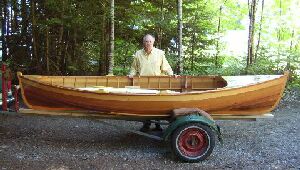
Modified Thomson-Malyea Hand Troller --- $45 + $5 S&H
Length overall 14 feet, moulded beam 44-1/2", mid-depth 16".
Full working drawings. Two sheets 24x36, drawn at 1/8 scale. Plans show general layout, construction sections, lines and offsets, materials and scantlings listing, sail plan, oars and spars, stringseat details, and brief history. Construction is traditional strip-planking, edge-nailed and glued, with bent ribs. Sprit-rig, area 26sf. The original 13-foot boat was built by Roy Malyea in 1937 in Gibsons, British Columbia. Will Thomson built two copies in 1964 & '65. I used Will's measurements and increased the length to 14 feet to carry passengers better.
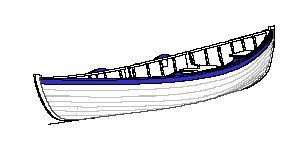
Grundison Hand Troller, 1946 --- $35 + $5 S&H
Length overall 14 feet, moulded beam 45-7/8", mid-depth 16-5/8".
Full working drawings. One sheet 24x36, drawn at 1/8 scale. Plans show general layout, construction sections, lines and offsets, plank widths, materials and scantlings listing, spoon oars, herring rake, and brief history. Construction is traditional carvel-planking with bent ribs. This boat was not rigged to sail. John Grundison built three handliners with his sons Bob and Bill in 1944, '45, and '46, so they could go fishing in the area around Victoria, British Columbia. This plan was drawn from the third one they built. Bob is still using it for sport.
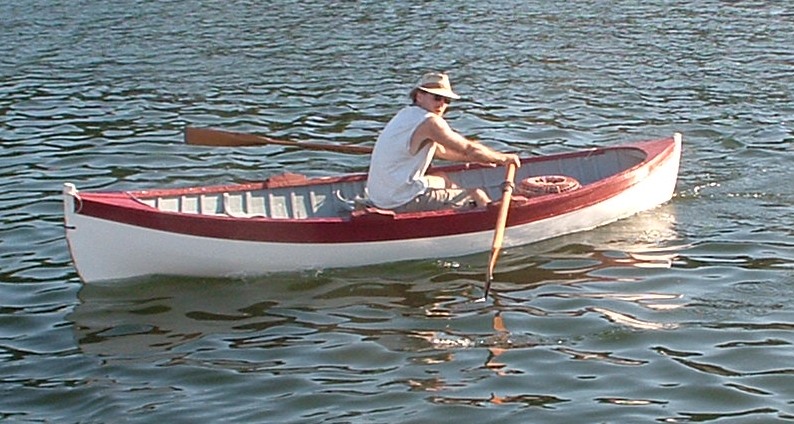
"Bus Bailey" Hand-Troller --- $45 + $5 S&H
Length overall 13'-5¾", outside beam 46¾", mid-depth 15½".
Full working drawings. Two 24x36 sheets drawn at 1/8 scale. Plans show general layout, construction sections, lines and offsets, materials and scantlings listing, two sail plans, oars and spars, plank widths, and brief history. Construction is carvel-planking with bent ribs (cedar on oak).
This boat was built in 1937 at the Luoma family boatshop on Shack Island, near Nanaimo, for the man whose name it now bears. It was used for handlining for salmon around Nanaimo and as far away as Cape Mudge. It has been restored by Colin Masson (Blog Link), who rows it frequently for pleasure and competition - and for commuting. Google "Bus Bailey" for more information.
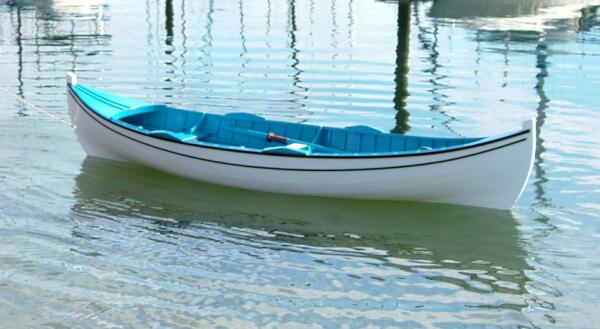
Evans Hand-Troller, 1930's
I prepared these plans for the Sunshine Coast Museum and they can only be ordered from them. The original was built in Roberts Creek, British Columbia by Canadian author Hubert Evans. His article "Day of the Hand Troller" is one of very few first-hand accounts of the handline fishery in BC.
Length overall 14'-7", moulded beam 44-3/8", mid-depth 15-3/8".
Full working drawings. Two sheets 24 x 36 drawn at 1/8 scale. Plans show general layout, construction sections, lines and offsets, materials and scantlings listing, sail plan, oars and spars, perspective view, plank widths, and brief history. Construction is traditional carvel-planking with bent ribs.
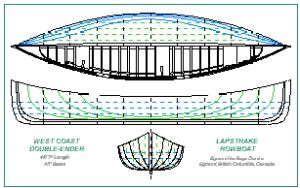
West Coast Lapstrake Double-Ender --- $35 + $5 S&H
This classic BC rowboat was reconstructed from an old set of builder's moulds with dimensions and notes written on them. The moulds were from the estate of Fisherman George Richardson of Parksville, BC, and are now at the Egmont Heritage Centre Museum, Egmont, BC.
Length overall 15'-7", moulded beam 44", mid-depth 16".
Full working drawings. One sheet 24x36 drawn at 1/8 scale. Plans show general layout, construction sections, lines and offsets, materials and scantlings, sail plan, and brief history. Construction is clinker planking with bent ribs.
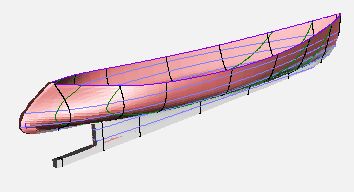
From an old half-model collected in New Brunswick in the 1960's by the late Ray MacKean, author of "The Little Boats".
Length overall 25-1/2 feet, moulded beam 53", mid-depth 27-5/8", draft 19-1/2".
One sheet 24 x 36 drawn at 1/12 scale: lines and offsets only, brief history and notes. No structural details. This slim boat is typical of many early power-boats that sought high speeds with the heavy-duty low-horsepower gasoline engines then available. Hull type is round-bilged double-wedge with built-down wineglass sections aft, and a distinctive torpedo stern.
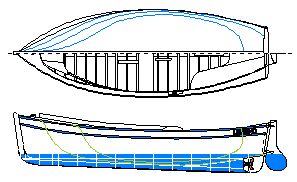
Length overall 13 feet, moulded beam 54", mid-depth 21-1/2".
Full working drawings. One 24 x 36 sheet shows lines, construction sections, general arrangement, engine installation, offsets, and materials. Boats like this were known as 'putt-putts' or 'putters' because of the sound of the slow-running single-cylinder engines typically used. The original was built at Gibsons Landing, British Columbia. It uses a very narrow-planked variant of carvel. Unlike the usual strip-plank system, planks are fastened only to the frame, not edge-nailed to each other. Frames are bent oak.
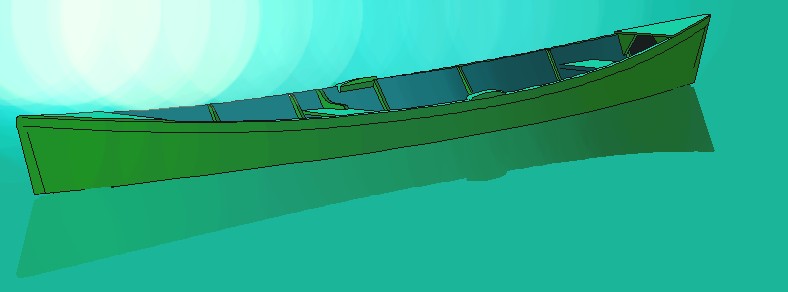
Length overall 18 feet, moulded beam 45", mid-depth 14½".
Full working drawings. One 24 x 36 sheet drawn to 1/12 scale shows lines, construction sections, general arrangement, offsets, and materials. The double-ended Fraser River Skiffs developed from transport bateaux introduced to the west coast by the early fur traders. This boat is one of the smallest of the type, suited for fast rowing with a single rower, and up to two passengers. It was reconstructed from research and a photograph taken at New Westminster, BC, circa 1905. Construction shown is typical bateau, with a smooth flat bottom and flaring clinker sides. Planking was originally cedar, now plywood can also be used. Frames are natural or laminated crooks of fir.